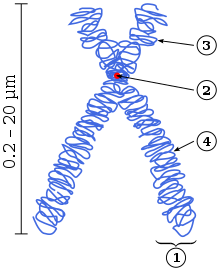Monocentric chromosome

The monocentric chromosome is a chromosome that has only one centromere in a chromosome and forms a narrow constriction.
Monocentric centromeres are the most common structure on highly repetitive DNA in plants and animals.[1]
Structure
Monocentric chromosomes as compared to
Holocentric chromosomes are found throughout the plant and animal kingdoms such as the nematode Caenorhabditis elegans.[3] Holocentric chromosomes do have an evolutionary advantage by preventing the loss of chromosome after a DNA double-strand break.[4]
The centromere is the point of attachment for the
Chromosomal aberrations
Deletions, duplications and translocations can produce a polycentric chromosome. This is troublesome for cells that divide often since at the time of anaphase the polycentric chromosome does not move to opposite poles of spindle fiber and the cell dies.[5]
See also
References
- PMID 30337534.
- PMID 22737088.
- PMID 11402076.
- PMID 28942791.
- ^ ISBN 978-0-12-227080-2, 10.1006/rwgn.2001.1750.}}
